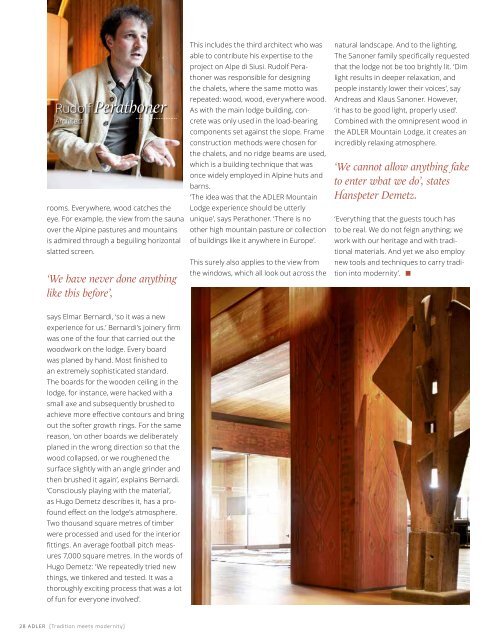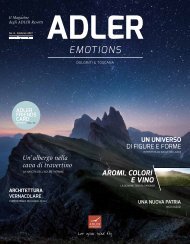Create successful ePaper yourself
Turn your PDF publications into a flip-book with our unique Google optimized e-Paper software.
Rudolf Perathoner<br />
Architect<br />
rooms. Everywhere, wood catches the<br />
eye. For example, the view from the sauna<br />
over the Alpine pastures and mountains<br />
is admired through a beguiling horizontal<br />
slatted screen.<br />
‘We have never done anything<br />
like this before’,<br />
says Elmar Bernardi, ‘so it was a new<br />
experience for us.’ Bernardi’s joinery firm<br />
was one of the four that carried out the<br />
woodwork on the lodge. Every board<br />
was planed by hand. Most finished to<br />
an extremely sophisticated standard.<br />
The boards for the wooden ceiling in the<br />
lodge, for instance, were hacked with a<br />
small axe and subsequently brushed to<br />
achieve more effective contours and bring<br />
out the softer growth rings. For the same<br />
reason, ‘on other boards we deliberately<br />
planed in the wrong direction so that the<br />
wood collapsed, or we roughened the<br />
surface slightly with an angle grinder and<br />
then brushed it again’, explains Bernardi.<br />
‘Consciously playing with the material’,<br />
as Hugo Demetz describes it, has a profound<br />
effect on the lodge’s atmosphere.<br />
Two thousand square metres of timber<br />
were processed and used for the interior<br />
fittings. An average football pitch measures<br />
7,000 square metres. In the words of<br />
Hugo Demetz: ‘We repeatedly tried new<br />
things, we tinkered and tested. It was a<br />
thoroughly exciting process that was a lot<br />
of fun for everyone involved’.<br />
This includes the third architect who was<br />
able to contribute his expertise to the<br />
project on Alpe di Siusi. Rudolf Perathoner<br />
was responsible for designing<br />
the chalets, where the same motto was<br />
repeated: wood, wood, everywhere wood.<br />
As with the main lodge building, concrete<br />
was only used in the load-bearing<br />
components set against the slope. Frame<br />
construction methods were chosen for<br />
the chalets, and no ridge beams are used,<br />
which is a building technique that was<br />
once widely employed in Alpine huts and<br />
barns.<br />
‘The idea was that the <strong>ADLER</strong> Mountain<br />
Lodge experience should be utterly<br />
unique’, says Perathoner. ‘There is no<br />
other high mountain pasture or collection<br />
of buildings like it anywhere in Europe’.<br />
This surely also applies to the view from<br />
the windows, which all look out across the<br />
natural landscape. And to the lighting.<br />
The Sanoner family specifically requested<br />
that the lodge not be too brightly lit. ‘Dim<br />
light results in deeper relaxation, and<br />
people instantly lower their voices’, say<br />
Andreas and Klaus Sanoner. However,<br />
‘it has to be good light, properly used’.<br />
Combined with the omnipresent wood in<br />
the <strong>ADLER</strong> Mountain Lodge, it creates an<br />
incredibly relaxing atmosphere.<br />
‘We cannot allow anything fake<br />
to enter what we do’, states<br />
Hanspeter Demetz.<br />
‘Everything that the guests touch has<br />
to be real. We do not feign anything; we<br />
work with our heritage and with traditional<br />
materials. And yet we also employ<br />
new tools and techniques to carry tradition<br />
into modernity’.<br />
Native trees<br />
and their history<br />
Hanspeter Demetz 2016<br />
The European Larch (Larix decidua).<br />
In the Southern Alps, this steadfast giant grows as high as the top of the<br />
tree line at 2,500 m above sea level, where only the Swiss pine is capable of<br />
keeping it company.<br />
Larch forests are flooded with light. Meadows and pastures thrive between<br />
the mighty trunks that can grow to up to 3 m in diameter and 50 m in<br />
height.<br />
The larch is deciduous, turning in autumn into a blaze of red and gold<br />
before its needles fall for the winter’s rest.<br />
Its timber is stronger and more durable than any other softwood. Alpine<br />
master builders and carpenters use it for load-bearing elements in wooden<br />
buildings, joiners for windows, doors and furniture. Its resin – called Lerget<br />
in South Tyrol – has been used as a natural remedy for treating a variety of<br />
complaints since time immemorial. The fragrant turpentine oils derived from<br />
it are used in many spa treatments.<br />
The European Larch is rewarded for its generosity with a very long lifespan:<br />
the Val d’Ultimo in South Tyrol is home to three larches that are over 800<br />
years old.<br />
The unassuming evergreen Norway spruce (Picea abies), The Swiss stone pine (Pinus cembra),<br />
often simply referred to as spruce and a member of the pine family, also known as the Arolla pine, Swiss pine or Stone pine,<br />
grows almost everywhere in central and northern Europe, thriving grows almost exclusively in the Alps and Carpathians,<br />
particularly in the cooler regions of the Alps and Scandinavia. Being a preferring locations close to the tree line or just above<br />
versatile tree that grows straight and fast, it is the ‘bread and butter’ it, where – often clinging onto rocks and boulders – it<br />
of the timber industry. However, it darkens the forests without any can still grow to 25 m in height and 1000 years of age.<br />
consideration for others, robbing the undergrowth of light and<br />
Between its five-needled fascicles grow the cedar nuts,<br />
overacidifying the soil with dropped needles, which impede all other the seeds of which – pine nuts – are used in the cuisine<br />
growth apart from its own.<br />
of the Dolomite valleys and for distilling schnapps. Its<br />
At the same time, it brings pleasure to people through music: a small wood has a highly aromatic fragrance and is used for<br />
mutation – tiny diagonal growths in the trunk wood – makes some of furniture and carving. Its volatile essential oils – which<br />
these trees into singing pines. They provide the wood for instrument last for decades – ensure a deep and restful sleep.<br />
makers. These are particularly common on the Alpe di Siusi and in the<br />
forests of the neighbouring Val di Fassa, and people here even talk Statues of saints have been carved in Val Gardena<br />
about the singing forests. The famous violin makers Stradivari, Amati from stone pine wood for centuries, and the designer<br />
and del Gesù from Mantua obtained the wood for their exquisite<br />
Pininfarina and his colleagues used it to craft sleek,<br />
stringed instruments here.<br />
luxury car bodywork shapes for decades.<br />
28 <strong>ADLER</strong> [Tradition meets modernity] [Native trees] <strong>ADLER</strong> 29







